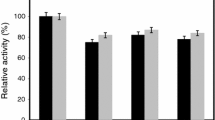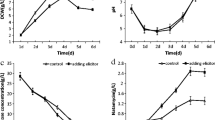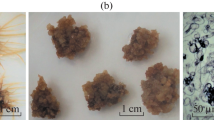Abstract
Rhizopus oryzae PR7 MTCC 9642 was a dimorphic fungus that showed a regular 90 days cycle of filament (mycelium) to pellet (yeast) transformation through a distinct bottom dwelling intermediate state and the pellets never revert back to filamentous form. Apart from the normal cycle, high temperature (37°C and above) and extreme pH also induced the yeast formation. Among the ions tested, calcium and chloride ions were found to restore the filamentous morphology, even in extreme pH and temperature. Cysteine HCl also played noteworthy role in maintaining mycelial growth even at adverse condition. Immobilized spores showed the appearance of intermediate form instead of typical yeast form even at high temperature. The strain could produce a number of extracellular hydrolytic enzymes like cellulolytic, xylanolytic, pectinolytic and amylolytic enzymes. The pellet and mycelial forms were found to be a better producer of cellulase–lignocellulase enzymes and amylolytic enzymes respectively, which might be correlated with their infectivity. Increase in inoculum size, agitation during cultivation, change in carbon and nitrogen source failed to induce mycelial growth in extreme conditions, which might be explained as irreversible change of configuration of protein responsible for mycelial development.






Similar content being viewed by others
References
Goulart RC, Martin JM (2005) Reversion by calcium of a yeast like development to the original filamentous form of the 10V10 5-flurocytosine sensitive mutant of Aspergillus niger. Braz J Microbiol 36:301–306
Morrow CA, Fraser JA (2009) Sexual reproduction and dimorphism in the pathogenic basidiomycetes. FEMS Yeast Res 9:161–177
Hornby JM, Jacobitz-Kizzier SM, McNeel DJ, Jensen EC, Treves DS, Nickerson KW (2004) Inoculum size effect in dimorphic fungi: extracellular control of yeast-mycelium dimorphism in Ceratocystis ulmi. Appl Environ Microbiol 70:1356–1359
Nadal M, García-Pedrajas MD, Scott E, Gold SE (2008) Dimorphism in fungal plant pathogens. FEMS Microbiol Lett 284:127–134
Maresca B, Lambowitz AM, Kumar VB, Grant GA, Kobayashi GS, Medoff G (1981) Role of cysteine in regulating morphogenesis in the dimorphic fungus Histoplasma capsulatum. Proc Natl Acad Sci USA 78:4596–4600
San Blas G, San Blas F (1984) Molecular aspects of fungal dimorphism. Crit Rev Microbiol 11:101–127
Muthukumar G, Nickerson KW (1984) Ca(II)-calmodulin regulation of fungal dimorphism in Ceratocystis ulmi. J Bact 159:382–390
Da Silva SP, Felipe MSS, Pereira M, Azevedo MO, Soares CMDA (1994) Phase transition and stage-specific protein synthesis in the dimorphic fungus Paracoccidioides brasiliensis. Exp Mycol 18:294–299
Sánchez-Martínez C, Pérez-Martín J (2001) Dimorphism in fungal pathogens: Candida albicans and Ustilago maydis—similar inputs, different outputs. Curr Opin Microbiol 4:214–221
Cao C, Li R, Wan Z, Liu W, Wang X, Qiao J, Wang D, Bulmer G, Calderone R (2007) The effects of temperature, pH, and salinity on the growth and dimorphism of Penicillium marneffei. Med Mycol 45:401–407
Liao W, Liu Y, Chen S (2007) Studying pellet formation of a filamentous fungus Rhizopus oryzae to enhance organic acid production. Appl Biochem Biotechnol 137–140:689–701
Orlowski M (1991) Mucor dimorphism. Microbiol Mol Biol Rev 55:234–258
Skory CD (2003) Induction of Rhizopus oryzae decarboxylase genes. Curr Microbiol 47:59–64
Zhang ZY, Jin B, Kelly JM (2007) Effects of cultivation parameters on the morphology of Rhizopus arrhizus and the lactic acid production in a bubble column reactor. Eng Life Sci 7:490–496
Liu Y, Liao W, Chen S (2007) Study of pellet formation of filamentous fungi Rhizopus oryzae using a multiple logistic regression model. Biotechnol Bioeng 99:117–128
Karmakar M, Ray RR (2010) Extra cellular endoglucanase production by Rhizopus oryzae in solid and liquid state fermentation of agro wastes. Asian J Biotechnol 2:27–36
Ghosh B, Ray RR (2010) Saccharification of raw native starches by extracellular isoamylase of Rhizopus oryzae. Biotechnology 9:224–228
Ray RR, Chakraverty R (1998) Extracellular [beta]-amylase from Syncephalastrum racemosum. Mycol Res 102:1563–1567
Noisommit-Rizzi N, Kastle A, Pritschow A, Reuss M (1996) Growth analysis of a mixed culture during the degradation of 4-aminobenzene-sulfonic acid. Biotechnol Tech 10:173–178
Bernfeld P (1955) Amylases α and β. Method Enzymol 1:149–158
Ray RR, Jana SC, Nanda G (1995) β-amalyse production by immobilized cells of Bacillus megaterium B6. J Basic Microbiol 35:113–116
Ruchel R, Schaffrinski M (1999) Versatile fluroscent staining of fungi in clinical specimens by using optical brightener blakophor. J Clin Microbiol 37:2694–2696
Campos CB, Di Benedette JP, Morais FV, Ovalle R, Nobrega MP (2008) Evidence for the role of calcineurin in morphogenesis and calcium homeostasis during mycelium-to-yeast dimorphism of Paracoccidioides brasiliensis. Eukaryot Cell 7:1856–1864
Chandler JM, Treece ER, Trenary HR, Brenneman JL, Flickner TJ (2008) Protein profiling of the dimorphic, pathogenic fungus, Penicillium marneffei. Proteome Sci 6:17
Wartmann T, Krüger A, Adler K, Duc BM (1995) Temperature-dependent dimorphism of the yeast Arxula adeninivorans Ls3. Antonie van Leeuwenhoek 68:215–223
Ray RR, Jana SC, Nanda G (1994) Biochemical approaches of increasing thermostability of β-amylase from Bacillus megaterium B6. FEBS Lett 356:30–32
Ruiz-Herrera J (2002) Different effectors of dimorphism in Yarrowia lipolytica. Arch Microbiol 178:477–483
Zhou Y, Du J, Tsao GT (2000) Mycelial pellet formation by Rhizopus oryzae ATCC 20344. Appl Biochem Biotechnol 84–86:779–789
Funtikova NS, Mysyakina IS (2004) The dependence of dimorphism in the fungus Mucor lusitanicus 12M on the preparation conditions of sporangiospores. Microbiology 73:734–736
Funtikova NS, Mysyakina IS (2003) Sporangiospores of the fungus Mucor lusitanicus 12M: correlation between lipid composition, viability, and morphology of growth upon germination. Mikrobiolgiia 72:775–779
Funtikova NS, Mysyakina IS (2008) Metabolic characteristics and lipid composition of yeast like cells and mycelium of Mucor circinelloides var, lusitanicus INMI grown at a high glucose content in the medium. Microbiology 77:407–411
Medoff G, Painter A, Kobayashi GS (1987) Mycelial to yeast phase transition of the dimorphic fungi Blastomyces dermatitidis and Paracoccidioides brasiliensis. J Bact 169:4055–4060
Kulkarni RK, Nickerson KW (1981) Nutritional control of dimorphism in Ceratocystis ulmi. Exp Mycol 5:148–154
Suzuki M, Morita T, Iwamoto T (2006) Diversity of Cl− channels. Cell Mol Life Sci 63(1):12–24
Vriesekoop F, Rasmusson M, Pamment NB (2002) Respective effects of sodium and chloride ions on filament formation and growth and ethanol production in Zymomonas mobilis fermentations. Lett Appl Microbiol 35:27–31
Acknowledgment
The authors wish to thank the University Grants Commission, New Delhi for the financial assistance.
Author information
Authors and Affiliations
Corresponding author
Rights and permissions
About this article
Cite this article
Karmakar, M., Ghosh, B. & Ray, R.R. Effect of Extracellular Factors on Growth and Dimorphism of Rhizopus oryzae with Multiple Enzyme Synthesizing Ability. Indian J Microbiol 52, 215–221 (2012). https://doi.org/10.1007/s12088-011-0197-z
Received:
Accepted:
Published:
Issue Date:
DOI: https://doi.org/10.1007/s12088-011-0197-z




